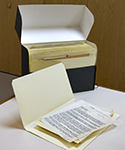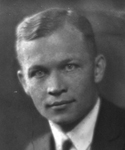Anaconda Geological Documents Collection
The Anaconda Geological Documents Collection is the scientific product of the Anaconda Company’s 90 year program of exploration and development work throughout the United States and in 110 foreign countries. It has been described as the largest and most significant body of economic geological data in the world. Consisting of more than 54 tons of material and 1.8 million documents, the Anaconda Collection contains a wealth of material useful in exploration, development and environmental studies.
Bernard Majewski Papers
Bernard L. Majewski started working for Deep Rock Oil Corporation of Tulsa, Oklahoma, in 1917 and eventually became head of marketing and a vice-president. Deep Rock sold its bulk marketing facilities in the Chicago, Illinois, area to Majewski in 1951 and he started the Great American Oil Company. He also served on the National Recovery Administration's Petroleum Industry Planning and Coordination Committee from 1933-1935, the Petroleum Administration for War during World War II and was active with the National Petroleum Council and the American Petroleum Institute.
Thayer Lindsley Papers
Thayer Lindsley, one of the 20th century's most prominent mine developers, was president of ten mining companies and on the boards of fifteen others. He was also a director of Canada's Crown Trust Company. His mining enterprises extended over five continents. In 1952 he became chairman of the board for Williston Oil and Gas Company. His collection includes mining reports, maps, legal agreements, and business correspondence referencing mines all over the world owned both by Lindsley and others.
Homestake Mining Company Records
In 1876, Moses and Fred Manual established the Homestake Mine near Bobtail Gulch in South Dakota. A year later George Hearst and others helped the Manuel Brothers to incorporate and the Homestake Mining Company was formed. The Homestake Mining Company records include information such as drill logs, assays, and maps about mine sites and mining activities in the Rocky Mountain Region including the states of Wyoming and South Dakota. The bulk of the information relates to uranium mining in Wyoming from 1952 to 1989.
M. King Hubbert Papers
M. King Hubbert is best-known for being the first scientist to articulate a model for depletion of energy resources, a theory that came to be known as "peak oil," or "Hubbert's curve. His collection contains correspondence; lectures and class notes on physics and geology; publications and reprints; extensive research notes and subject files; glass negatives; maps & charts; and miscellaneous artifacts.
Wagon Wheel Information Committee Records
The Wagon Wheel Information Committee formed in 1971 to halt the proposed use of underground nuclear blasting for natural gas exploration south of Pinedale, Wyoming. The collection contains material related to the committee's successful efforts to keep Project Wagon Wheel from occurring.
Midwest Oil Corporation Records
The Midwest Oil Company, incorporated in Arizona in 1911, played a major role in the development of Wyoming's Salt Creek oil field. In 1951 it merged with the Saltmount Company and Mountain Producers Corporation to form the Midwest Oil Corporation. Materials include minute books, articles of incorporation, balance sheets, financial statements, correspondence, income tax records, oil depletion and reserves reports, legal papers and court documents.
Kemmerer Coal Company Records
The Kemmerer Coal Company was founded in 1897 by Patrick J. Quealy (1857-1930), Mahlon S. Kemmerer (d. 1926) and his son, John L. Kemmerer with Quealy serving as president. Quealy and the Kemmerers also established the town of Kemmerer in Lincoln County, Wyoming in 1897. The collection contains correspondence and letterpress books, coal mining and labor relations, miscellaneous financial materials, and the development of the town of Kemmerer, Wyoming.




